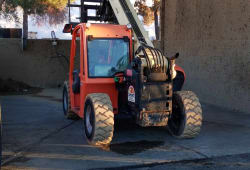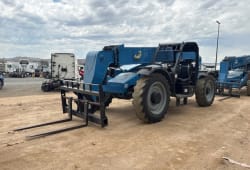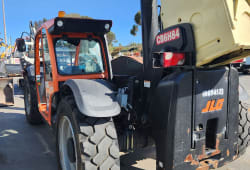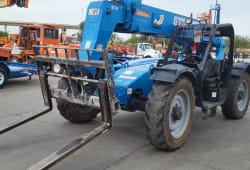From Farms to Factories: The Telehandlers Methods Revolutionizing Industries
9 Lectura mínima
)
enero 19, 2024
In the world of material handling and construction, one machine has emerged as a true workhorse - the telehandler. Also recognized as telescopic handlers or telehandler forklifts, these multifunctional marvels have transformed industries through their exceptional capabilities. With a telescoping boom that extends both vertically and horizontally, telehandlers seamlessly combine the functionalities of a forklift and a crane. This unique fusion of lifting prowess and precision makes them invaluable across a spectrum of sectors, including construction, agriculture, manufacturing, and more. Whether it's reaching great heights, handling heavy loads, or accessing tight spaces, they stand as versatile vehicles that empower modern industries to achieve their tasks with unparalleled precision and power.
What is a telehandler?
A telehandler, also known as a telescopic handler, is a versatile machine with a telescoping boom. It combines the functions of a forklift and a crane, capable of lifting, carrying, and reaching both horizontally and vertically. Key features include a telescopic boom, forklift attachments, and various attachments for diverse applications.
Importance of Telehandlers in Various Industries
They are vital in various industries due to their exceptional versatility and efficiency. They enable safe and efficient material handling, access to elevated areas, and precise load placement, contributing significantly to productivity, safety, and operational flexibility in sectors ranging from agriculture and construction to manufacturing and utilities. Their adaptability to diverse applications makes them a cornerstone of modern industrial operations.
Types
They come in various types, each tailored for specific tasks. Categories include standard, compact, and high-reach. Specialized models cater to unique applications, such as rotating telehandlers for increased maneuverability and agricultural telehandlers for farm tasks like hay handling and equipment lifting. Usage in Agriculture
They play a pivotal role in modern agriculture, enhancing efficiency and versatility on farms. They are invaluable for tasks such as loading and stacking hay bales, transporting feed and materials, and handling equipment. Their telescopic booms enable them to reach high areas in barns or silos, making them indispensable for various agricultural operations. Their ability to switch between different attachments, like forks, buckets, and grapples, makes them versatile for diverse tasks. They have revolutionized farming by providing precision and power, reducing labor, and improving overall productivity on farms of all sizes.
Usage in Construction
Telehandlers are indispensable on construction sites, offering exceptional versatility. They excel at handling heavy materials, from bricks to steel beams, and can access elevated areas with ease. This versatility streamlines construction projects, enhancing efficiency and reducing labor requirements. Their telescopic booms provide the reach needed for various job site requirements, while their adaptability to different attachments further expands their usefulness. In short, they significantly benefit construction by increasing productivity, improving safety, and offering cost-effective solutions for a wide range of tasks.
Usage in Manufacturing and Warehousing
They play a crucial role in manufacturing by efficiently handling materials within factories. They streamline production processes by swiftly moving raw materials, components, and finished products. Their adaptability to various attachments ensures precise material placement, contributing to enhanced productivity and reduced manual labor.
In warehousing, telehandlers excel at tasks like moving and stacking pallets, loading and unloading trucks, and optimizing storage space. Their telescopic booms enable them to reach high shelves and navigate tight spaces, maximizing warehouse efficiency.
They benefit manufacturing and warehousing industries by improving material handling efficiency, reducing labor costs, and maximizing space utilization, ultimately leading to enhanced operational productivity.
Usage in Energy and Utilities
They play a vital role in the energy sector, particularly in the demanding environments of the oil and gas industry. They are used for tasks such as handling heavy equipment, transporting materials, and accessing elevated areas in power plants. Their versatility and lifting capacity are essential for ensuring the smooth operation of energy facilities.
In utilities, telehandlers are employed for the installation and maintenance of utility lines, as well as accessing elevated infrastructure for repairs. Their telescopic booms and adaptability to various attachments make them indispensable tools for utility workers.
They bring efficiency and safety to the energy and utilities sectors by enhancing material handling, reducing downtime, and providing access to hard-to-reach areas. Their role in these industries ensures reliable energy production and utility services.
Telehandler Safety and Best Practices
Operator Training and Certification
Proper operator training is paramount to telehandler safety. Operators must undergo comprehensive training to operate these versatile machines safely. Certification requirements and standards, often governed by industry regulations, ensure that operators have the necessary skills and knowledge to handle telehandlers safely and efficiently.
Safety Measures
Telehandlers are equipped with safety features, including load sensors, to prevent accidents. Operator protection systems, such as cabs with rollover protection, enhance worker safety. Regular maintenance and inspections are crucial for ensuring machine reliability and safety. Implementing safety precautions specific to different industries, like construction or agriculture, is essential to effectively address industry-specific hazards and risks.
Innovations and Future Trends in Telehandlers
:format(webp)) Remote Control and Automation
Remote Control and Automation
The future of telehandlers is marked by advancements in automation. These features enable operators to control telehandlers from a distance, enhancing safety and efficiency. Automation technologies streamline tasks, such as load positioning and leveling, improving overall productivity.
Environmental Considerations
They are adapting to environmental concerns, with an emphasis on reduced emissions and enhanced fuel efficiency. Sustainable construction practices are being integrated into telehandler design, aligning with eco-friendly standards and regulations, thus reducing their carbon footprint.
Telematics and Connectivity
Telematics and connectivity are transforming telehandler operations. Integration with digital systems allows for real-time data collection and analysis, optimizing performance and maintenance schedules.
Enhanced Safety Systems
Safety remains a top priority with evolving technologies, including collision avoidance systems and improved operator protection features, ensuring that telehandlers continue to operate with enhanced safety measures in place.
Techniques for Efficient Load Handling and Positioning
Efficient load handling and positioning with a telehandler require a combination of skill, knowledge, and adherence to safety guidelines. Telehandlers are versatile machines designed to perform a variety of tasks, but to maximize their efficiency, operators must follow specific techniques:
Proper Load Assessment: Before attempting to handle a load, operators should assess its weight, dimensions, and any special requirements. This assessment helps determine the appropriate attachment, boom extension, and load capacity settings.
Balanced Load Placement: Always ensure that the load is balanced and evenly distributed on the forks or attachments. An uneven load can lead to instability and potential accidents. Position the load as close to the telehandler's front wheels as possible for better balance.
Smooth Movements: Telehandler operators should employ smooth and controlled movements when lifting, lowering, or maneuvering a load. Jerky or abrupt actions can destabilize the machine and the load.
Appropriate Attachment Selection: Telehandlers can be fitted with various attachments, including forks, buckets, and grapples. Select the attachment that best suits the task at hand, ensuring it is securely attached and compatible with the load.
Smooth Transitions: When positioning a load, use the telehandler's telescopic boom to smoothly and precisely place it in the desired location. Ensure that the load is lowered steadily and without sudden movements.
Operator Visibility: Maintain clear visibility of both the load and the surrounding area. Adjust the operator's position as needed to ensure a clear line of sight, especially when working at elevated heights or with obstructed views.
Ground Conditions: Consider the terrain and ground conditions when positioning a load. Rough or uneven surfaces can impact stability, so operators should exercise caution and use stabilizers if necessary.
Safety Protocols: Adhere to safety guidelines and protocols at all times. Ensure that the telehandler is on stable ground, with outriggers deployed if required. Use seat belts and other safety features provided by the machine.
Case Studies and Success Stories
Real-World Applications
Telehandlers have left a lasting impact across diverse industries, and real-world applications exemplify their versatility and efficacy.
In the construction sector, they have revolutionized material handling. A prime example is their role in the construction of skyscrapers, where they efficiently transport heavy construction materials to towering heights, reducing manual labor and project timelines.
In agriculture, telehandlers have transformed the way farms operate. Success stories abound in the hay and forage industry, where telehandlers streamline the harvesting process, speeding up baling, stacking, and transporting tasks.
In manufacturing, telehandlers have increased productivity significantly. They excel at swiftly moving materials within factories, making just-in-time production feasible, and optimizing operational efficiency.
These real-world applications underscore the undeniable impact of telehandlers, proving their worth as essential tools in a multitude of industries, improving efficiency, reducing labor, and contributing to successful projects worldwide.
Conclusion
Telehandlers stand as indispensable machines that have redefined material handling and lifting tasks across various industries. Their importance lies in their exceptional versatility, combining the functions of forklifts and cranes into a single, adaptable unit. From agriculture to construction, manufacturing to utilities, and beyond, telehandlers have left an indelible mark by enhancing efficiency, reducing labor requirements, and improving safety.
These remarkable machines have revolutionized diverse industries by streamlining processes, enabling access to elevated areas, and optimizing material handling. They have played a pivotal role in the success of numerous projects, from construction sites to farms and factories.
Looking ahead, they hold promising prospects. The ongoing evolution of telehandler technology promises increased automation, improved fuel efficiency, and enhanced safety measures. As industries continue to embrace sustainability, telehandlers are set to align with eco-friendly construction practices, contributing to a greener and more efficient future.
In short, telehandlers are not merely machines; they are catalysts for progress, transforming industries, and shaping the future of material handling and lifting operations.















